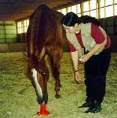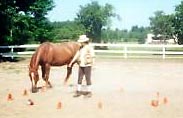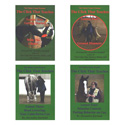You can also begin to incorporate the clicker into your horse's regular training. Indy, a six year old half arabian gelding came to me in June for training. He was a kind, beautifully-mannered horse. His owner/breeder had never had time to saddle-break him, so at six he had a lot of catching up to do. During the worst of the summer heat when the temperature was creeping towards 100 and neither of us wanted to work hard, I introduced him to the clicker. He was slow to catch on. It took three sessions before he finally got the connection between touching the cone and getting grain. After that there was no stopping him. He became an enthusiastic over-achiever. He needed only minutes to shift from touching one cone to touching a whole circle of cones. (Figs. 7a, 7b).

Fig. 7a: Even with the
temperature in the high
90's, I can still do some
training. I'm introducing
this unbroken half-Arab
to the clicker. He could
wander off, or he could
pester me for grain.
Instead he's focused on
earning his treats.

Fig. 7b: Now I've taken Indy outside.
He is totally free to leave, but instead
he is choosing to walk round my circle
of cones touching each one in sequence,
just to earn a tablespoon of grain.
At this point he'd been under saddle for about four weeks. He was proving to be a wonderfully steady horse with lively gaits, and an incredibly soft, responsive mouth. The next step with the clicker was to use it for ground work to teach Indy shoulder-in. The clicker now became linked to movement. Indy had no trouble making the connection. Twenty easy minutes into his first in-hand session he was moving down the track in beautiful shoulder-in. (Fig. 8)
The third step in the process was to introduce the clicker under saddle. (Fig. 9) I worked Indy in-hand for about a week before beginning this process. I used what he was learning with the clicker. Under saddle I asked him to rotate into shoulder-in. As he began to respond correctly, I clicked. Indy startled to a full stop (a sure sign that he has clearly understood the clicker). His ears airplaned around as he tried to figure out what was happening.

Fig. 8: Now that Indy understands the
clicker, I can use it in his regular training.
Here I'm introducing him to shoulder-in.
I scratched Indy just in front of his withers. Normally I use food as the reward. It's so easy to give, and it's usually by far the strongest motivator, but Indy was still at the stage where grain got him excited. Since he was just starting under saddle, I thought he'd do better with a simple scratch.
Indy accepted scratching as his treat, and when I asked for the next step of shoulder-in, he moved easily into it, using what he had learned in-hand to present me with rewardable behavior. He was recognizing cues for a complex pattern of movement, and offering that movement to me under saddle, with no strain or resistance. The clicker bypassed what can be a long and often frustrating stage in training for both the horse and the rider.

Fig. 9: Indy has been working under saddle
for about two weeks when this picture was
taken. The clicker quickly helped him
become comfortable with a rider. Note the
lightness of the rein, and the relaxed,
soft carriage of his topline.
The clicker got Indy off to a good start under saddle. It kept his body sound and his mind relaxed while he went beyond basics into the "dance" of lateral work. It let us develop a common language that could lead to an uncommon partnership. With the clicker Indy became incredibly soft and responsive, presenting work which was a thrill to ride.
Even if you never want to take the clicker this far into your everyday training, taking the time to teach simple tricks is a valuable exercise. The principles of good training are the same whether you are teaching a horse to touch a cone, or to jump a fence. Clarity is important in all training, and that is what the clicker and operant conditioning teach.








dartmoor pony
I am more familiar with dog and sea lion training but my sister is having problems with her dartmoor pony who is showing destructive behavior when unsupervised in the stables pulling things off the shelves knocking thigs over, a previous owner said he'd even eaten parts off his car!!!! I'm not too familiar with horse behavior but would i be right in thinking this could be due to bordem? he doesnt socialise with the other horses so I was wondering if he'd benefit from so clicker training to keep him mentally stimulated? what do you think?
dogs v horses
I have used clicker training with my blue healer, and it worked beautifully. I haven't tried it with the horses yet, but there is no doubt it will work, as horses are so attuned to the slightest stimulus in their environment.
Wess
http://www.blog.cowboyhorsetraining.com
Post new comment